This is personal study note
Copyright and original reference:
www.youtube.com/watch?v=GJW6trVTDWM&list=PLbhbGI_ppZISMV4tAWHlytBqNq1-lb8bz
================================================================================
Gaussian Mixture Model
- In 2D, multiple points
- GMM finds clusters of those points
- GMM can be used in 2D, 3D, 4D, ...
================================================================================
Space and time are different thing
time
- irreversible
How you can model some algorithm with adding "time" component
================================================================================
 - How HMM can be expressed?
- HMM can also be expressed by graphical model
- What is the major research questions in HMM?
- To inspect research questions with HMM, you should know how to calculate probabilities, how to inference probabilities
- Link HMM with previous lectures
- EM algorithm (which is used for GMM) is also used for HMM
================================================================================
- How HMM can be expressed?
- HMM can also be expressed by graphical model
- What is the major research questions in HMM?
- To inspect research questions with HMM, you should know how to calculate probabilities, how to inference probabilities
- Link HMM with previous lectures
- EM algorithm (which is used for GMM) is also used for HMM
================================================================================
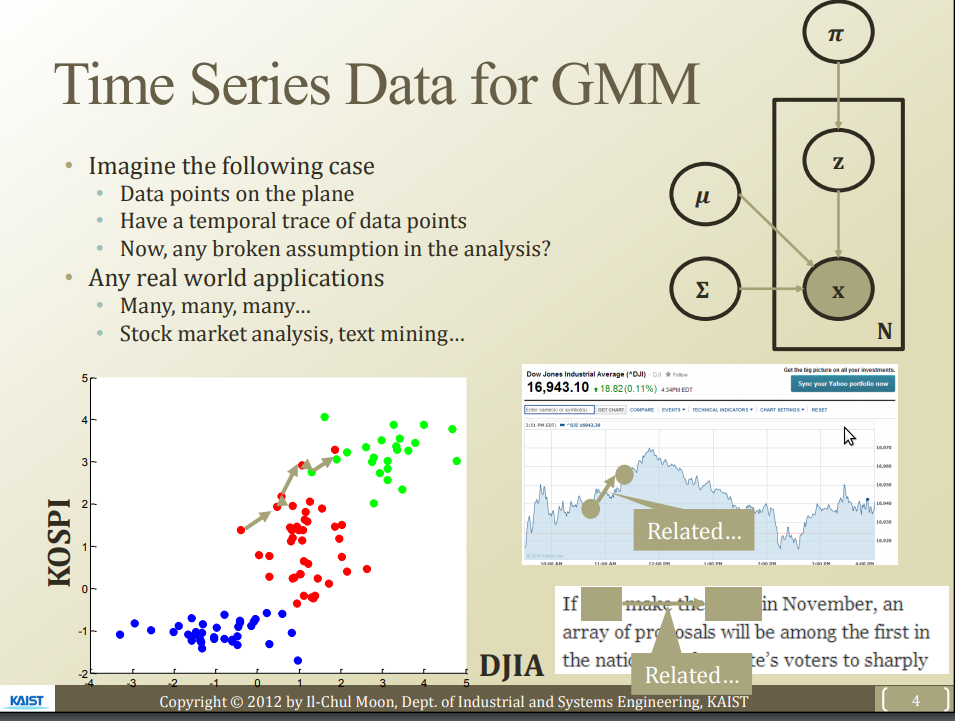 ================================================================================
================================================================================
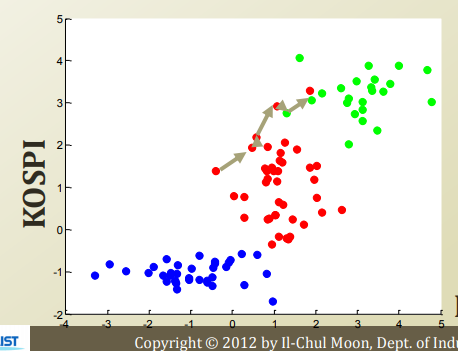 * Not considering "time information"
* It contains "spatial information"
* 3 clusters
================================================================================
* Not considering "time information"
* It contains "spatial information"
* 3 clusters
================================================================================
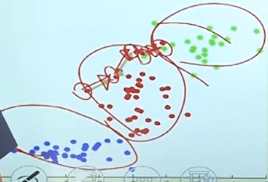 * What if points move based on time flow?
* Then, how should Gaussian Mixture Model change?
================================================================================
* What if points move based on time flow?
* Then, how should Gaussian Mixture Model change?
================================================================================
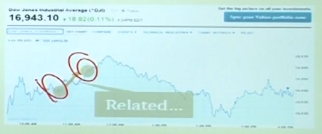 * "Moving point in time flow" is shown in various fields
* "Value at yesterday" and "value at today" has relationship
* In other words, "value at yesterday" affects "value at today"
* And there can be latent driving force (random variable) which moves those values
================================================================================
* "Moving point in time flow" is shown in various fields
* "Value at yesterday" and "value at today" has relationship
* In other words, "value at yesterday" affects "value at today"
* And there can be latent driving force (random variable) which moves those values
================================================================================
 * Latent driving force can be changed, resulting in different value-pattern
================================================================================
Question:
It will be good if there is "time series based mixture model"
================================================================================
* Latent driving force can be changed, resulting in different value-pattern
================================================================================
Question:
It will be good if there is "time series based mixture model"
================================================================================
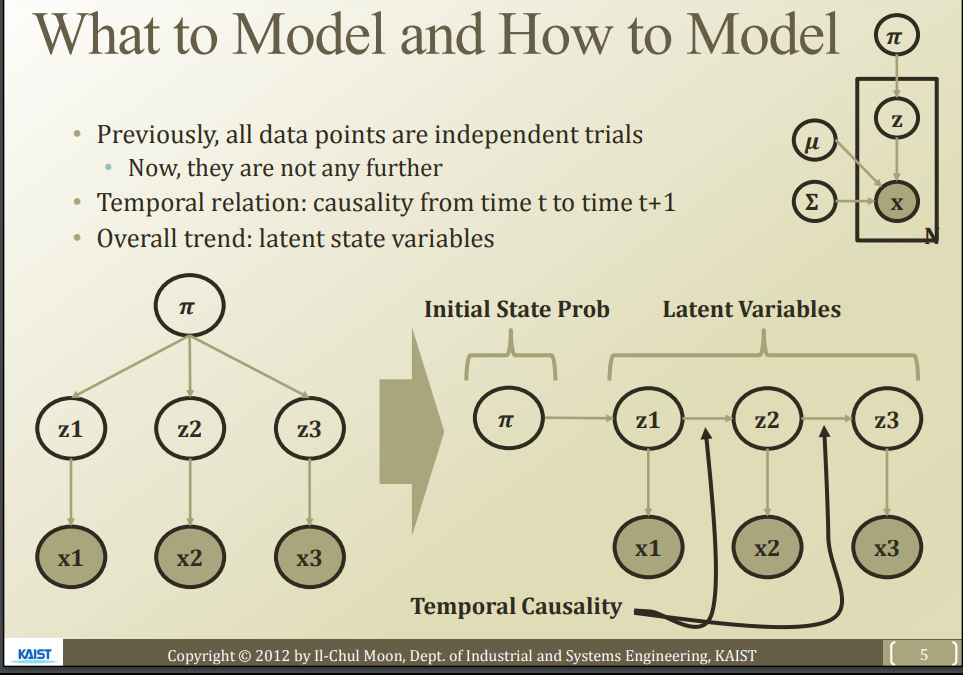
 * Gaussian Mixture Model in plate notation
* $$$N$$$: N number of data point which is expressed via x
* $$$z$$$: latent factor which classifies N number of data point into clusters
* $$$\pi, \mu, \sigma$$$: parameters, contributes z and x
================================================================================
* Gaussian Mixture Model in plate notation
* $$$N$$$: N number of data point which is expressed via x
* $$$z$$$: latent factor which classifies N number of data point into clusters
* $$$\pi, \mu, \sigma$$$: parameters, contributes z and x
================================================================================
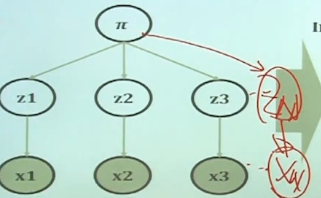 Unfolded view
* Parameter $$$\pi$$$ (which is modeled by multinomial distribution) affects latent factor z
* If parameter $$$\pi$$$ is fixed value, $$$z_1,z_2,\cdots,z_N$$$ are independent
* So, that case will not be good to expressen "time"
* So, above graphical model should be changed
================================================================================
Unfolded view
* Parameter $$$\pi$$$ (which is modeled by multinomial distribution) affects latent factor z
* If parameter $$$\pi$$$ is fixed value, $$$z_1,z_2,\cdots,z_N$$$ are independent
* So, that case will not be good to expressen "time"
* So, above graphical model should be changed
================================================================================
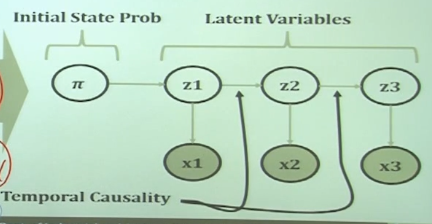 * Parameter $$$\pi$$$ affects $$$z_1$$$ (which is latent factor at time 1)
* $$$x_1$$$ is observed
* $$$z_1$$$ affects $$$z_2$$$ (next latent factor to consider "time information")
* This graphical model can model "the change of latent factors" in terms of time flow
================================================================================
"Hidden markov model" is the model where you considers GMM with "temporal causality"
Hidden Markov Model = dynamic clustering
================================================================================
* Parameter $$$\pi$$$ affects $$$z_1$$$ (which is latent factor at time 1)
* $$$x_1$$$ is observed
* $$$z_1$$$ affects $$$z_2$$$ (next latent factor to consider "time information")
* This graphical model can model "the change of latent factors" in terms of time flow
================================================================================
"Hidden markov model" is the model where you considers GMM with "temporal causality"
Hidden Markov Model = dynamic clustering
================================================================================
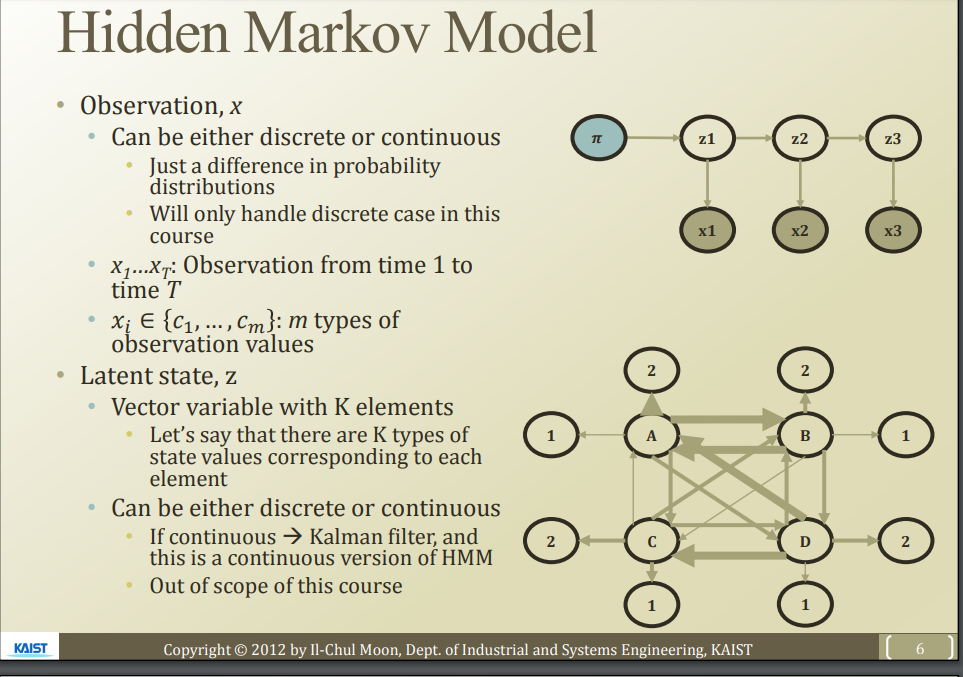 ================================================================================
HMM in graphical model
================================================================================
HMM in graphical model
 observarions: $$$ x_1, x_2, x_3$$$
observation: discret or continuous
Observation in GMM: continuous
================================================================================
observarions: $$$ x_1, x_2, x_3$$$
observation: discret or continuous
Observation in GMM: continuous
================================================================================
 Above relation is modeled by $$$P(x_1|z_1)$$$
Probability function P uses Gaussian normal distribution: continuous random variable is modeled
Probability function P uses binomial or multinomial distribution: discrete random variable is modeled
Probability distribution is your choice
================================================================================
Above relation is modeled by $$$P(x_1|z_1)$$$
Probability function P uses Gaussian normal distribution: continuous random variable is modeled
Probability function P uses binomial or multinomial distribution: discrete random variable is modeled
Probability distribution is your choice
================================================================================
 $$$x_1,x_2,\cdots,x_T$$$: observations (data points) which has temporal causality
$$$x_1$$$ is the thing before $$$x_2$$$
================================================================================
Each x can have multiple observations
$$$x_1,x_2,\cdots,x_T$$$: observations (data points) which has temporal causality
$$$x_1$$$ is the thing before $$$x_2$$$
================================================================================
Each x can have multiple observations
 In other words, it means x can be as vector
================================================================================
Latent (invisible) factor z
Latent state z
Suppose there is k number of dynamical time groups
================================================================================
In other words, it means x can be as vector
================================================================================
Latent (invisible) factor z
Latent state z
Suppose there is k number of dynamical time groups
================================================================================
 Suppose x_1 is involved in "1 time group"
Suppose there is no trend-change (no latent factor change)
Suppose x_2 is involved in "1 time group"
Suppose there is trend-change (latent factor change)
Suppose x_2 is involved in "2 time group"
================================================================================
Suppose x_1 is involved in "1 time group"
Suppose there is no trend-change (no latent factor change)
Suppose x_2 is involved in "1 time group"
Suppose there is trend-change (latent factor change)
Suppose x_2 is involved in "2 time group"
================================================================================
 K elements: K number of components
================================================================================
Continuous latent factor from HMM case: Kalman filter method
================================================================================
K elements: K number of components
================================================================================
Continuous latent factor from HMM case: Kalman filter method
================================================================================
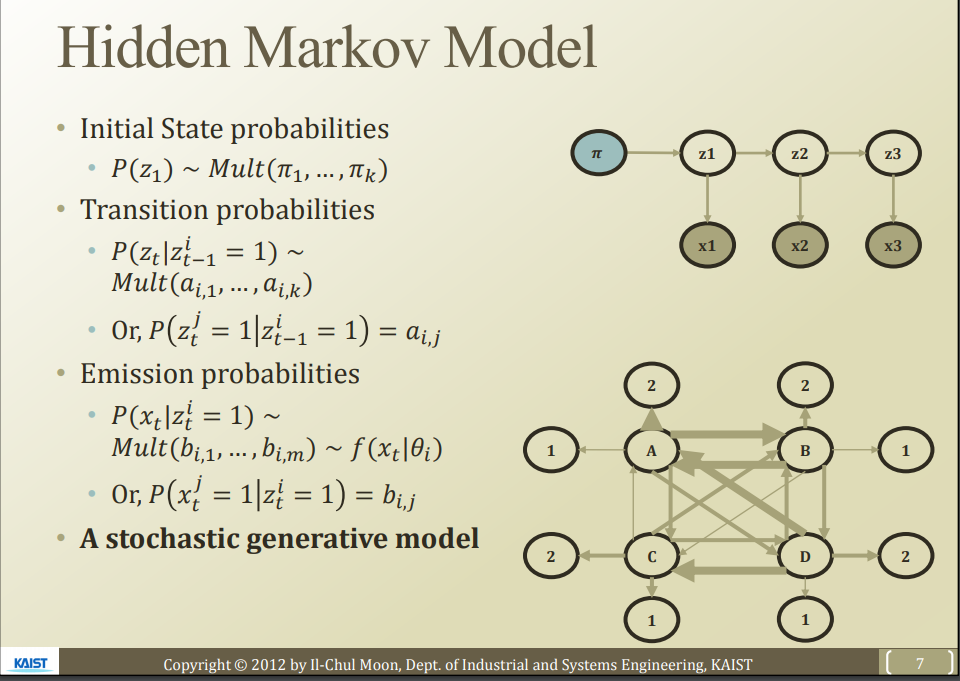 ================================================================================
================================================================================
 * Initial state probabilities
$$$P(z_1) \sim Mult(\{\pi_1,\pi_2,\cdots,\pi_N\})$$$
- First latent factor $$$z_1$$$ is sampled from Multinomial distribution
- That multinomial distribution has parameter $$$\pi$$$
- That means, to train HMM, you should infer that $$$\pi$$$
================================================================================
* Initial state probabilities
$$$P(z_1) \sim Mult(\{\pi_1,\pi_2,\cdots,\pi_N\})$$$
- First latent factor $$$z_1$$$ is sampled from Multinomial distribution
- That multinomial distribution has parameter $$$\pi$$$
- That means, to train HMM, you should infer that $$$\pi$$$
================================================================================
 * Transition probabilities
- probability of $$$z_1$$$ to $$$z_2$$$
- $$$P(z_t|z_{t-1}^i=1) \sim Mult(\{\alpha_{i,1},\alpha_{i,2},\cdots,\alpha_{i,k}\})$$$
- at previous time, z is involved in 1, at current time, probability of cluster of z
- $$$z_{t-1}^i=1$$$: z's time cluster at previous time
- $$$z_t$$$: z's time cluster at current time
- Parameter $$$\alpha$$$ in Mult
- Other form
- $$$P(z_t^j=1|z_{t-1}^i=1) = \alpha_{i,j}$$$
$$$z_{t-1}^i=1$$$: z in i-th cluster is given
$$$z_t^j=1$$$: z in j-th cluster
================================================================================
* Transition probabilities
- probability of $$$z_1$$$ to $$$z_2$$$
- $$$P(z_t|z_{t-1}^i=1) \sim Mult(\{\alpha_{i,1},\alpha_{i,2},\cdots,\alpha_{i,k}\})$$$
- at previous time, z is involved in 1, at current time, probability of cluster of z
- $$$z_{t-1}^i=1$$$: z's time cluster at previous time
- $$$z_t$$$: z's time cluster at current time
- Parameter $$$\alpha$$$ in Mult
- Other form
- $$$P(z_t^j=1|z_{t-1}^i=1) = \alpha_{i,j}$$$
$$$z_{t-1}^i=1$$$: z in i-th cluster is given
$$$z_t^j=1$$$: z in j-th cluster
================================================================================
 - Above edge is modeled by "emission probabilities"
$$$P(x_t|z_t^i=1) \sim Mult(b_{i,1},\cdots,b_{i,m}) \sim f(x_t|\theta_t)$$$
* $$$z_t^i$$$: latent factor z (in i-th cluster) is given
* $$$x_t$$$ visible observation x
* Since you suppose that you deal with discrete case,
* you use Multinomial function to model x
* b is parameter for Multinomial function
* m number of possible discrete observations
* How $$$b_{i,j}$$$ is modeled
- $$$P(x_t^j=1|z_t^i=1) = b_{i,j}$$$
- $$$z_t^i=1$$$ z: (in ith cluster) is given
- probability of j-th observation
================================================================================
- Above edge is modeled by "emission probabilities"
$$$P(x_t|z_t^i=1) \sim Mult(b_{i,1},\cdots,b_{i,m}) \sim f(x_t|\theta_t)$$$
* $$$z_t^i$$$: latent factor z (in i-th cluster) is given
* $$$x_t$$$ visible observation x
* Since you suppose that you deal with discrete case,
* you use Multinomial function to model x
* b is parameter for Multinomial function
* m number of possible discrete observations
* How $$$b_{i,j}$$$ is modeled
- $$$P(x_t^j=1|z_t^i=1) = b_{i,j}$$$
- $$$z_t^i=1$$$ z: (in ith cluster) is given
- probability of j-th observation
================================================================================

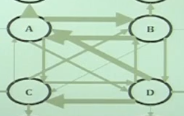 - Suppose A, B, C, D are latent factors
- State A ---> State B ---> State C .... based on probability, state changes
- Suppose A, B, C, D are latent factors
- State A ---> State B ---> State C .... based on probability, state changes
 - Each state can express 1 or 2 as observations based on probability
================================================================================
Example
State: professor is in anger
You: you can't actually know professor's mind (state, and state is hidden)
And via, for example, facial expression of professor, you can see the observation emitted from professor's mind state
- (Mind) state of professor (latent factor z) can change (or does transition as time goes)
- Professor's facial expression always looks changing
But (inner mind of professor) latent factor can stay in same state
- In conclusion, the main characterisitc of HMM is that
as time goes, "latent factors z" and "observations which are emited from latent factor z" are separated
- Each state can express 1 or 2 as observations based on probability
================================================================================
Example
State: professor is in anger
You: you can't actually know professor's mind (state, and state is hidden)
And via, for example, facial expression of professor, you can see the observation emitted from professor's mind state
- (Mind) state of professor (latent factor z) can change (or does transition as time goes)
- Professor's facial expression always looks changing
But (inner mind of professor) latent factor can stay in same state
- In conclusion, the main characterisitc of HMM is that
as time goes, "latent factors z" and "observations which are emited from latent factor z" are separated























